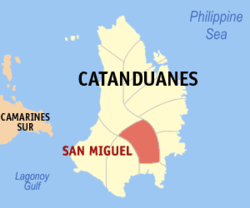San Miguel, Catanduanes
| San Miguel | ||
|---|---|---|
| Municipality | ||
| ||
 Map of Catanduanes with San Miguel highlighted | ||
.svg.png) San Miguel Location within the Philippines | ||
| Coordinates: 13°38′N 124°18′E / 13.633°N 124.300°ECoordinates: 13°38′N 124°18′E / 13.633°N 124.300°E | ||
| Country | Philippines | |
| Region | Bicol (Region V) | |
| Province | Catanduanes | |
| District | Lone district | |
| Founded | August 23, 1952 | |
| Barangays | 24 | |
| Government[1] | ||
| • Mayor | Edna R. Bernal | |
| Area[2] | ||
| • Total | 129.94 km2 (50.17 sq mi) | |
| Population (2010)[3] | ||
| • Total | 14,107 | |
| • Density | 110/km2 (280/sq mi) | |
| Time zone | PST (UTC+8) | |
| Zip Code | 4802 | |
| Dialing code | 52 | |
San Miguel is a fifth class municipality in the province of Catanduanes, Philippines. According to the 2010 census, it has a population of 14,107 people.[3]
The Municipality of San Miguel is located at the mid-south part of the province of Catanduanes, the only inland municipality of the island. It is bounded on the north by the municipality of Caramoran, on the east by the municipality of Baras and Gigmoto, on the west by the municipality of Virac and on the south by the municipality of Bato.
Barangays
San Miguel is politically subdivided into 24 barangays.[2]
|
|
History
San Miguel, which was formerly part of the Municipality of Bato, was first inhabited by the early mountaineers and the part of the Malayan race that were pushed to the open valley with the coming of the Spanish Colonizers.
There are myths and fables about how the town got its name. According to a pioneer, San Miguel was once a sitio originally known as "Aguas" named after fish species bigger than the "Balanak". In the 1930s during the celebration of the feast in honor of Santa Cruz, the former patron saint, Aguas was changed to San Miguel in grateful recognition and commendation to the invaluable services of Don Miguel Triumfante and Juez de Cnado of Bato who were present then during the celebration.
There was also a legend handed down to the present generation that once upon a time the chapel caretaker in the person of Marcelo Tapanan, in one early morning heard a long and loud ringing of bells. He hurried to the chapel and was surprised to see the image of Saint Michael the Archangel in the altar. The story passed on every ear of the residents and finally made a common move of changing the name of the place from Aguas to San Miguel.
San Miguel became a separate municipality through then President Elpidio Quirino's Executive Order No. 803 dated August 23, 1952, comprising twelve barangays at that time. The first town mayor was Torribio Taopa who was chosen through a plebiscite in 1952 until the first local elections in 1953 where he won.
The present mayor is Edna Bernal who is on her second-term after winning over former Mayor and former SP Francisco Camano Jr.
Demographics
| Population census of San Miguel | ||
|---|---|---|
| Year | Pop. | ±% p.a. |
| 1990 | 11,587 | — |
| 1995 | 12,052 | +0.74% |
| 2000 | 12,205 | +0.27% |
| 2007 | 12,966 | +0.84% |
| 2010 | 14,107 | +3.12% |
| Source: National Statistics Office[3][4] | ||
References
- ↑ "Municipalities". Quezon City, Philippines: Department of the Interior and Local Government. Retrieved 20 January 2013.
- 1 2 "Province: Catanduanes". PSGC Interactive. Makati City, Philippines: National Statistical Coordination Board. Retrieved 20 January 2013.
- 1 2 3 4 5 "Total Population by Province, City, Municipality and Barangay: as of May 1, 2010" (PDF). 2010 Census of Population and Housing. National Statistics Office. Retrieved 20 January 2013.
- ↑ "Province of Catanduanes". Municipality Population Data. LWUA Research Division. Retrieved 24 July 2013.
External links
 |
Caramoran | |
Gigmoto |  |
| |
Baras | |||
| ||||
| | ||||
| Virac | Bato |
